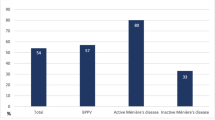Abstract
This study aimed to determine the prevalence and mechanism of linear vertigo reported by the patients during the attacks of benign paroxysmal positional vertigo (BPPV). We prospectively evaluated the characteristics (rotational vs. linear) of positional vertigo in 70 patients with posterior and horizontal canal BPPV using a questionnaire allowing multiple choices. In patients with linear vertigo, we further assessed the directionality of linear vertigo. We adopted the velocity-storage model to explain the occurrence and direction of linear vertigo in these patients with BPPV. Patients reported only rotational vertigo in 46 (46/70, 65.7%), only linear vertigo in 10 (14.3%), and both rotational and linear vertigo in 14 (20%). The patients experienced fear from rotational vertigo in 54 (54/70, 77.1%) and from linear vertigo in 20 (20/70, 28.6%). The direction of linear vertigo was concordant with the direction of inertial acceleration predicted by the velocity-storage model. Patients with BPPV may experience linear as well as rotational vertigo during the attacks. This linear vertigo may be ascribed to centrally estimated inertial acceleration.





Similar content being viewed by others
References
Bhattacharyya N, Gubbels SP, Schwartz SR, Edlow JA, El-Kashlan H, Fife T, et al. Clinical practice guideline: benign paroxysmal positional vertigo (update). Otolaryngol Head Neck Surg. 2017;156(3_suppl):S1–S47.
von Brevern M, Radtke A, Lezius F, Feldmann M, Ziese T, Lempert T, et al. Epidemiology of benign paroxysmal positional vertigo: a population based study. J Neurol Neurosurg Psychiatry. 2007;78(7):710–5.
Kim JS, Oh SY, Lee SH, Kang JH, Kim DU, Jeong SH, et al. Randomized clinical trial for geotropic horizontal canal benign paroxysmal positional vertigo. Neurology. 2012;79(7):700–7.
Kim JS, Oh SY, Lee SH, Kang JH, Kim DU, Jeong SH, et al. Randomized clinical trial for apogeotropic horizontal canal benign paroxysmal positional vertigo. Neurology. 2012;78(3):159–66.
Oh HJ, Kim JS, Han BI, Lim JG. Predicting a successful treatment in posterior canal benign paroxysmal positional vertigo. Neurology. 2007;68(15):1219–22.
Furman JM, Cass SP. Benign paroxysmal positional vertigo. N Engl J Med. 1999;341(21):1590–6.
Kim JS, Zee DS. Clinical practice. Benign paroxysmal positional vertigo. N Engl J Med. 2014;370(12):1138–47.
Angelaki DE, Shaikh AG, Green AM, Dickman JD. Neurons compute internal models of the physical laws of motion. Nature. 2004;430(6999):560–4.
Choi JY, Glasauer S, Kim JH, Zee DS, Kim JS. Characteristics and mechanism of apogeotropic central positional nystagmus. Brain. 2018;141(3):762–75.
Glasauer S. Interaction of semicircular canals and otoliths in the processing structure of the subjective zenith. Ann N Y Acad Sci. 1992;656:847–9.
Laurens J, Angelaki DE. The functional significance of velocity storage and its dependence on gravity. Exp Brain Res. 2011;210(3–4):407–22.
Merfeld DM, Zupan L, Peterka RJ. Humans use internal models to estimate gravity and linear acceleration. Nature. 1999;398(6728):615–8.
Rabbitt RD. Semicircular canal biomechanics in health and disease. J Neurophysiol. 2019;121(3):732–55.
Lee SU, Choi JY, Kim HJ, Park JJ, Zee DS, Kim JS. Impaired tilt suppression of post-rotatory nystagmus and cross-coupled head-shaking nystagmus in cerebellar lesions: image mapping study. Cerebellum. 2017;16(1):95–102.
Holly JE, Cohen HS, Masood MA. Assessing misperception of rotation in benign paroxysmal positional vertigo with static and dynamic visual images. J Vestib Res. 2019;29(5):271–9.
Kolev OI, Georgieva-Zhostova S. Illusory self-motion perception evoked by caloric vestibular stimulation in sitting versus supine body positions. Behav Brain Res. 2014;272:150–5.
Fujimoto C, Suzuki S, Kinoshita M, Egami N, Sugasawa K, Iwasaki S. Clinical features of otolith organ-specific vestibular dysfunction. Clin Neurophysiol. 2018;129(1):238–45.
Jung I, Ahn SH, Lee J, Lee SU, Oh HJ, Kim HJ, et al. Age-related deterioration of saccule-related neural function is associated with decreased estimated glomerular filtration rate and increased free thyroxine. Clin Neurophysiol. 2019;130(5):795–801.
Funding
This study was supported by Basic Science Research Program through the National Research Foundation of Korea (NRF) funded by the Ministry of Science and ICT (2020R1A2C4002281).
Author information
Authors and Affiliations
Contributions
Jeong-Yoon Choi conceptualized the study, acquired the data, analyzed the data, performed statistics and model simulation, and drafted the manuscript; Young-Min Park, Seung Hoon Lee, Ji-Eun Choi, Seung Won Hyun, Jung-Mi Song, and Hyo-Jung Kim acquired and analyzed the data. Hui Jong Ho and Ji-Soo Kim conceptualized the study and revised the manuscript.
Corresponding author
Ethics declarations
The institutional review board of Seoul National University Bundang hospital approved the protocol of this prospective observational study (IRB number: B-1412/277-003).
Conflict of Interest
J-S Kim serves as an Associate Editor of Frontiers in Neuro-Otology and on the editorial boards of the Journal of Clinical Neurology, Frontiers in Neuro-ophthalmology, Journal of Neuro-Ophthalmology, Journal of Vestibular Research, and the Journal of Neurology, and Medicine. Other authors have nothing to disclose.
Additional information
Publisher’s Note
Springer Nature remains neutral with regard to jurisdictional claims in published maps and institutional affiliations.
Rights and permissions
About this article
Cite this article
Choi, JY., Park, YM., Lee, S.H. et al. Linear Vertigo in Benign Paroxysmal Positional Vertigo: Prevalence and Mechanism. Cerebellum 20, 160–168 (2021). https://doi.org/10.1007/s12311-020-01196-6
Accepted:
Published:
Issue Date:
DOI: https://doi.org/10.1007/s12311-020-01196-6




